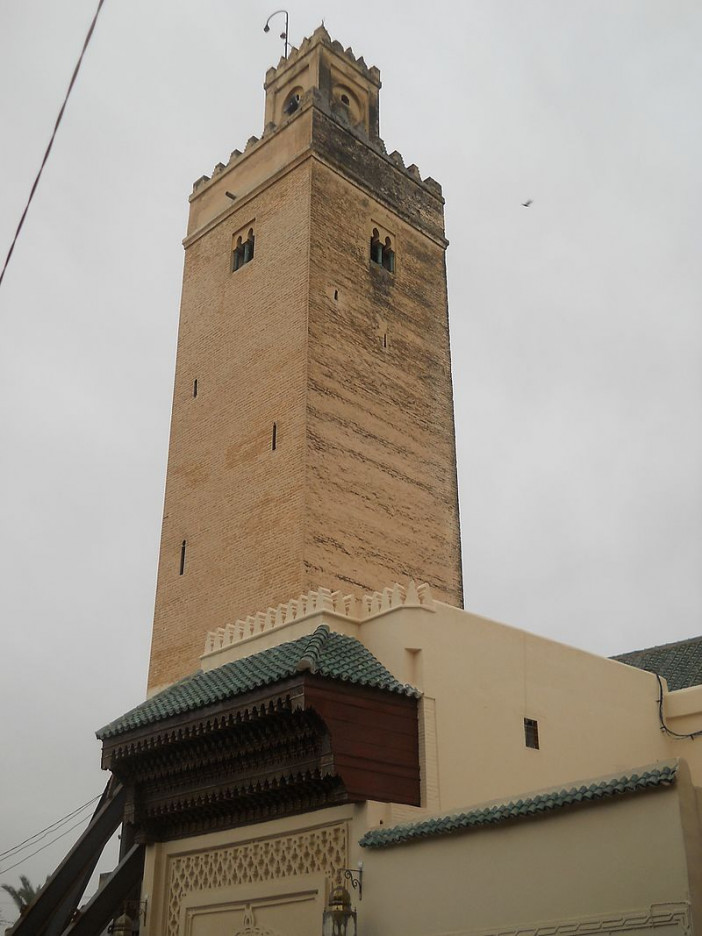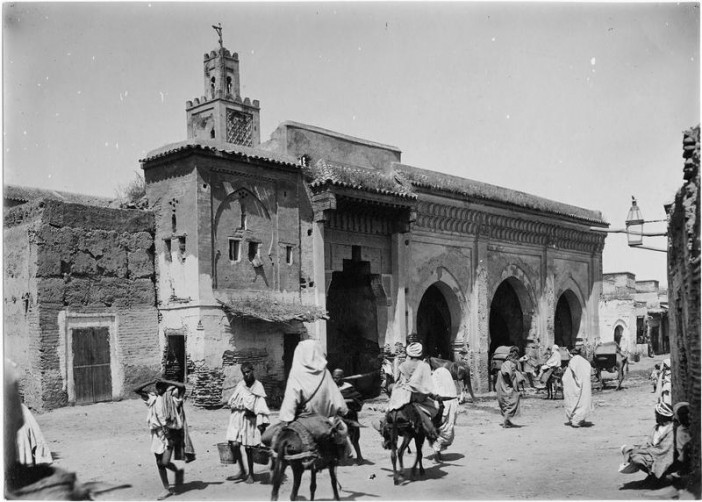Bab Guissa Mosque
History
The mosque is believed to have been built in the 14th century, under the Marinid sultan Abu al-(1331–1351) Hasan's reign, based on an inscription on one of its marble columns, though there is not a lot of evidence available. The Alaouite sultan Mohammed ibn Abdallah (1757-1790 CE) renovated and expanded the mosque while also constructing an adjacent madrasa near the end of the 18th century. At the end of the 19th century, the mosque reportedly underwent extensive restoration and alterations.
The mosque is called after the neighboring Bab Guissa, a city gate, which was named for the Zenata ruler al-Guissa ibn Dounas ( ), who constructed the initial gate by this name in the eleventh century.
Urban and Architectural
Mosque
The mosque is situated right within the northern city gate known as Bab Guissa and takes up an area of around 1440 square meters[3]. The mosque's minaret is noticeable on the northern skyline of the medina due to its elevated location in relation to the rest of Fes el-Bali (historic city).The minaret is unadorned and generally plain. The mosque's main entrance is located near to the minaret's base on its eastern side. A larger square frame with a band of darj-w-ktaf or sebka and interlacing semicircles around the doorway's arch are two examples of the traditional Moroccan patterns used to ornament Moroccan architecture (a pattern with shapes similar to palmettes or fleur-de-lys). A carved and painted wooden canopy is located above the door.
Traditional Moroccan architecture also features a wooden canopy that has been carved and painted above the door. A small outdoor gallery with wall fountains for ablutions (ritual washing before prayer) next to this entrance and adjacent to the city wall is embellished with mosaic tiles (zellij) in geometric designs as well as tiles painted with arabesques and Arabic calligraphy.
The main prayer hall is located on the mosque's southeast side, and it is surrounded on three sides by galleries. The interior of the mosque is dominated by the relatively wide courtyard, or sahn, which is typical of medieval Moroccan mosques. Although the courtyard features a customary central fountain, it also contains a number of uncommon fig trees that provide shade.The main prayer hall is only two rows deep and is somewhat short. A row of stained glass windows with grilles in geometric shapes is set into the upper portion of the wall that surrounds the mihrab (a niche on the qibla wall that designates the direction of prayer). The wall is lavishly ornamented with sculpted plaster.
Description
References
Le Tourneau, Roger (1949). Fès avant le protectorat : étude économique et sociale d'une ville de l'occident musulman. Casablanca: Société Marocaine de Librairie et d'Édition. pp. 132–133.
Touri, Abdelaziz; Benaboud, Mhammad; Boujibar El-Khatib, Naïma; Lakhdar, Kamal; Mezzine, Mohamed (2010). Le Maroc andalou : à la découverte d'un art de vivre (2 ed.). Ministère des Affaires Culturelles du Royaume du Maroc & Museum With No Frontiers. ISBN 978-3902782311.
Official signage posted outside the mosque.
"Bab Guissa Mosque and Madrasa | Archnet". archnet.org. Retrieved 2018-02-04.
Terrasse, Henri (1968). La Mosquée al-Qaraouiyin à Fès - avec une étude de Gaston Deverdun sur les inscriptions historiques de la mosquée. Paris: Librairie C. Klincksieck. pp. 21–22.
Maslow, Boris (1937). Les mosquées de Fès et du nord du Maroc. Paris: Éditions d'art et d'histoire. pp. 74–79.
Gaudio, Attilio (1982). Fès: Joyau de la civilisation islamique. Paris: Les Presse de l'UNESCO: Nouvelles Éditions Latines. ISBN 2723301591.
https://www.archnet.org/sites/1724
Details
Location
Fez, Morocco
Worshippers
3000
Owners
Abu al-Hasan Ali ibn Othman
Year of Build
14th century, 18th century (restored and expanded)
Area
1440 square meters[
Drawings
Map
History
The mosque is believed to have been built in the 14th century, under the Marinid sultan Abu al-(1331–1351) Hasan's reign, based on an inscription on one of its marble columns, though there is not a lot of evidence available. The Alaouite sultan Mohammed ibn Abdallah (1757-1790 CE) renovated and expanded the mosque while also constructing an adjacent madrasa near the end of the 18th century. At the end of the 19th century, the mosque reportedly underwent extensive restoration and alterations.
The mosque is called after the neighboring Bab Guissa, a city gate, which was named for the Zenata ruler al-Guissa ibn Dounas ( ), who constructed the initial gate by this name in the eleventh century.
Urban and Architectural
Mosque
The mosque is situated right within the northern city gate known as Bab Guissa and takes up an area of around 1440 square meters[3]. The mosque's minaret is noticeable on the northern skyline of the medina due to its elevated location in relation to the rest of Fes el-Bali (historic city).The minaret is unadorned and generally plain. The mosque's main entrance is located near to the minaret's base on its eastern side. A larger square frame with a band of darj-w-ktaf or sebka and interlacing semicircles around the doorway's arch are two examples of the traditional Moroccan patterns used to ornament Moroccan architecture (a pattern with shapes similar to palmettes or fleur-de-lys). A carved and painted wooden canopy is located above the door.
Traditional Moroccan architecture also features a wooden canopy that has been carved and painted above the door. A small outdoor gallery with wall fountains for ablutions (ritual washing before prayer) next to this entrance and adjacent to the city wall is embellished with mosaic tiles (zellij) in geometric designs as well as tiles painted with arabesques and Arabic calligraphy.
The main prayer hall is located on the mosque's southeast side, and it is surrounded on three sides by galleries. The interior of the mosque is dominated by the relatively wide courtyard, or sahn, which is typical of medieval Moroccan mosques. Although the courtyard features a customary central fountain, it also contains a number of uncommon fig trees that provide shade.The main prayer hall is only two rows deep and is somewhat short. A row of stained glass windows with grilles in geometric shapes is set into the upper portion of the wall that surrounds the mihrab (a niche on the qibla wall that designates the direction of prayer). The wall is lavishly ornamented with sculpted plaster.
Description





